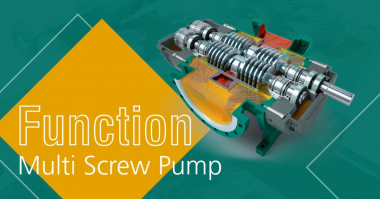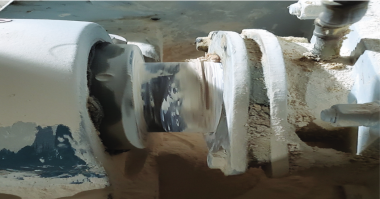What are composite pump performance curves? In this edition of the Centrifugal Pump Minute, James Farley, Senior Director of Product Management for Griswold, provides an overview of composite pump performance curves and the importance of using them to calculate pump efficiency.
The affinity laws are very accurate for small changes. If you’re using large changes or you can do a large speed change or a diameter change you should rely on test data because the affinity laws do not always take into account all the friction losses and various other aspects of the pump design. When you’re doing significant changes we recommend that you use published data from the pump manufacturer to understand how the pump performance is going to change. This is also why the pump manufacturer is going to publish what is considered a composite pump performance curve. It gives you more information about how the pump is going to operate given different characteristics.
I wanted to show you what this composite performance curve looks like and talk through it. Before we looked at a very basic pump performance curve that just had one impeller trim but this may not give you enough information to make a decision about how the pump’s going to operate at your specific required flow and head. A typical pump manufacturer is going to provide what’s called a composite pump curve. In this case, you’ll see that the composite curve now includes a variety of impeller trims. We still have our 10 inch trim but now we’ve got a nine and a quarter-inch trim as well as a six-inch trim. Now, the difference in these different curves is what you would see by doing the affinity law calculations. Because, as you change your impeller diameter and you make it smaller then as you reduce the impeller diameter the flow and head that the pump is going to generate is going to decline. As you can see, a 10-inch impeller is going to give the highest head, highest flow. The nine and a quarter is now a reduction in that. Then typically a manufacturer is going to define what the minimum impeller trim is that the pump is designed to operate at. In this case, it would be six inches and now at six inches, the pump’s performance has declined significantly when looking at head and flow. In order to, be able to communicate efficiency there’s an efficiency lines that are called ISO efficiency lines They look quite a bit different than the straight curve that I had shown earlier our performance curve but it makes it easier to understand how this pump’s going to operate when you start adding the composite curve or multiple impeller trims onto one chart. What you’re seeing here is a group of lines and each one of the lines represents a specific efficiency level. If you look farther to the right on one of these curves this pump has a 50 efficiency curve 55, 60, 65, and so forth up to what is published as best efficiency of 73.1. Now anywhere on that line is going to represent the particular efficiency that line is noted for (we’ll talk about how to interpret it in just a minute). Then you’re also going to get on a performance curve what are called ISO power lines and these ones again you’ll have multiple lines each line representing a specific horsepower or it could be kilowatt power that the pump is going to require during operation. When you put all these together you’re going to get what is considered a full composite pump performance curve, where you can see how the pumps can operate with different trims and how much power and efficiency those pumps are going to require as well as NPSH requirement.
Let’s go into how do you read this when you’re looking at a composite performance curve. Here we’ve added a dot in the curve to represent the condition of service that we want to understand how the pump is going to perform. In this particular situation, from that dot, you’re going to do a vertical and horizontal line. The vertical line will go down to the flow axis. In this example, the vertical line will hit the flow axis at 525 gallons per minute, that green dot on the curve is representing 525 gallons per minute for a pump that has a nine in a quarter impeller trim. If you take the horizontal line to the head axis you’re going to see that at 525 gallons per minute, the pump is going to generate 337 feet of head. From here we need to understand how efficient is this pump going to operate. As you can see this dot this rated point for the pump is between the 71 efficiency curve and the 73 efficiency curve lines. Now you’re going to need to pick the line that is closest to the dot and through interpolation, you’re going to have to interpret what that actual what the actual efficiency is at the rated condition or this green dot. Because the curve is or the dot is very close to the 73 curve this particular dot represents 72.8 percent efficiency. Now if that dot had been closer to the 71 line, then it would be closer to the 71 through interpolation this particular pump is going to operate at 72.8.
Then we would go into understanding and reading the power requirement for this particular condition. As you see here there are two curves that are on the outsides of our operating condition one curve represents 60 horsepower the other one represents 75. As you can see through some interpolation the condition of service is very close to the 60 horsepower curve and it would be interpreted at 61.5 horsepower. Now we’ve been able to identify the head flow efficiency and horsepower, then finally we would need to interpret the pump’s NPSH requirement. That’s down on the NPSH curve towards the bottom you’re going to take a vertical line straight down from the condition of service and draw through
the NPSH required curve and this will end up showing that this pump is going to require 13.6 feet of NPSH required.
Watch another Centrifugal Pump Minute video.




Comments